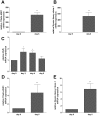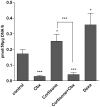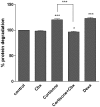Skeletal muscle 11beta-HSD1 controls glucocorticoid-induced proteolysis and expression of E3 ubiquitin ligases atrogin-1 and MuRF-1
- PMID: 21304964
- PMCID: PMC3031623
- DOI: 10.1371/journal.pone.0016674
Skeletal muscle 11beta-HSD1 controls glucocorticoid-induced proteolysis and expression of E3 ubiquitin ligases atrogin-1 and MuRF-1
Abstract
Recent studies demonstrated expression and activity of the intracellular cortisone-cortisol shuttle 11beta-hydroxysteroid dehydrogenase type 1 (11beta-HSD1) in skeletal muscle and inhibition of 11beta-HSD1 in muscle cells improved insulin sensitivity. Glucocorticoids induce muscle atrophy via increased expression of the E3 ubiquitin ligases Atrogin-1 (Muscle Atrophy F-box (MAFbx)) and MuRF-1 (Muscle RING-Finger-1). We hypothesized that 11beta-HSD1 controls glucocorticoid-induced expression of atrophy E3 ubiquitin ligases in skeletal muscle. Primary human myoblasts were generated from healthy volunteers. 11beta-HSD1-dependent protein degradation was analyzed by [(3)H]-tyrosine release assay. RT-PCR was used to determine mRNA expression of E3 ubiquitin ligases and 11beta-HSD1 activity was measured by conversion of radioactively labeled [(3)H]-cortisone to [(3)H]-cortisol separated by thin-layer chromatography. We here demonstrate that 11beta-HSD1 is expressed and biologically active in interconverting cortisone to active cortisol in murine skeletal muscle cells (C2C12) as well as in primary human myotubes. 11Beta-HSD1 expression increased during differentiation from myoblasts to mature myotubes (p < 0.01), suggesting a role of 11beta-HSD1 in skeletal muscle growth and differentiation. Treatment with cortisone increased protein degradation by about 20% (p < 0.001), which was paralleled by an elevation of Atrogin-1 and MuRF-1 mRNA expression (p < 0.01, respectively). Notably, pre-treatment with the 11beta-HSD1 inhibitor carbenoxolone (Cbx) completely abolished the effect of cortisone on protein degradation as well as on Atrogin-1 and MuRF-1 expression. In summary, our data suggest that 11beta-HSD1 controls glucocorticoid-induced protein degradation in human and murine skeletal muscle via regulation of the E3 ubiquitin ligases Atrogin-1 and MuRF-1.
Conflict of interest statement
Figures




Similar articles
-
Suppression of atrogin-1 and MuRF1 prevents dexamethasone-induced atrophy of cultured myotubes.Metabolism. 2013 Oct;62(10):1495-502. doi: 10.1016/j.metabol.2013.05.018. Epub 2013 Jul 15. Metabolism. 2013. PMID: 23866982
-
Forkhead box O3 plays a role in skeletal muscle atrophy through expression of E3 ubiquitin ligases MuRF-1 and atrogin-1 in Cushing's syndrome.Am J Physiol Endocrinol Metab. 2017 Jun 1;312(6):E495-E507. doi: 10.1152/ajpendo.00389.2016. Epub 2017 Feb 28. Am J Physiol Endocrinol Metab. 2017. PMID: 28246104
-
Muscle-specific E3 ubiquitin ligases are involved in muscle atrophy of cancer cachexia: an in vitro and in vivo study.Oncol Rep. 2015 May;33(5):2261-8. doi: 10.3892/or.2015.3845. Epub 2015 Mar 9. Oncol Rep. 2015. PMID: 25760630
-
The role of E3 ubiquitin-ligases MuRF-1 and MAFbx in loss of skeletal muscle mass.Free Radic Biol Med. 2016 Sep;98:218-230. doi: 10.1016/j.freeradbiomed.2015.12.031. Epub 2015 Dec 29. Free Radic Biol Med. 2016. PMID: 26738803 Review.
-
Biomarkers of Skeletal Muscle Atrophy Based on Atrogenes Evaluation: A Systematic Review and Meta-Analysis Study.Int J Mol Sci. 2025 Apr 9;26(8):3516. doi: 10.3390/ijms26083516. Int J Mol Sci. 2025. PMID: 40331994 Free PMC article.
Cited by
-
From Brain to Muscle: The Role of Muscle Tissue in Neurodegenerative Disorders.Biology (Basel). 2024 Sep 12;13(9):719. doi: 10.3390/biology13090719. Biology (Basel). 2024. PMID: 39336146 Free PMC article. Review.
-
11β-hydroxysteroid dehydrogenases: intracellular gate-keepers of tissue glucocorticoid action.Physiol Rev. 2013 Jul;93(3):1139-206. doi: 10.1152/physrev.00020.2012. Physiol Rev. 2013. PMID: 23899562 Free PMC article. Review.
-
Glucocorticoids and 11β-HSD1 are major regulators of intramyocellular protein metabolism.J Endocrinol. 2016 Jun;229(3):277-86. doi: 10.1530/JOE-16-0011. Epub 2016 Apr 5. J Endocrinol. 2016. PMID: 27048233 Free PMC article.
-
The relationship between temporal muscle thickness and disease activity in Cushing's disease.J Endocrinol Invest. 2023 Nov;46(11):2411-2420. doi: 10.1007/s40618-023-02195-0. Epub 2023 Sep 13. J Endocrinol Invest. 2023. PMID: 37704872
-
Musculoskeletal complications of Cushing syndrome.Reumatologia. 2023;61(4):271-282. doi: 10.5114/reum/169889. Epub 2023 Aug 31. Reumatologia. 2023. PMID: 37745145 Free PMC article. Review.
References
-
- Lindsay RS, Wake DJ, Nair S, Bunt J, Livingstone DE, et al. Subcutaneous adipose 11 beta-hydroxysteroid dehydrogenase type 1 activity and messenger ribonucleic acid levels are associated with adiposity and insulinemia in Pima Indians and Caucasians. J Clin Endocrinol Metab. 2003;88:2738–2744. - PubMed
-
- Engeli S, Bohnke J, Feldpausch M, Gorzelniak K, Heintze U, et al. Regulation of 11beta-HSD genes in human adipose tissue: influence of central obesity and weight loss. Obes Res. 2004;12:9–17. - PubMed
-
- Mariniello B, Ronconi V, Rilli S, Bernante P, Boscaro M, et al. Adipose tissue 11beta-hydroxysteroid dehydrogenase type 1 expression in obesity and Cushing's syndrome. Eur J Endocrinol. 2006;155:435–441. - PubMed
-
- Masuzaki H, Paterson J, Shinyama H, Morton NM, Mullins JJ, et al. A transgenic model of visceral obesity and the metabolic syndrome. Science. 2001;294:2166–2170. - PubMed
Publication types
MeSH terms
Substances
LinkOut - more resources
Full Text Sources
Molecular Biology Databases

